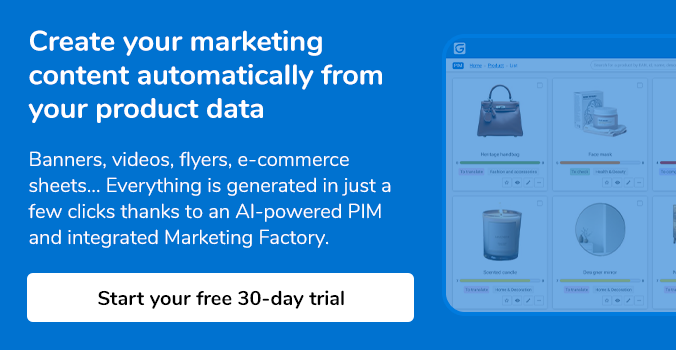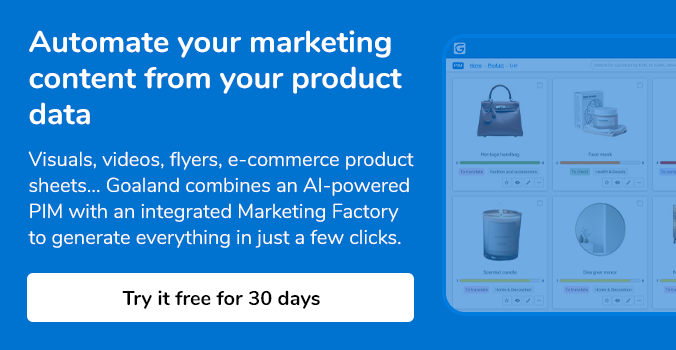Presenting the right product and/or service is no longer enough to entice clients. It has become essential to provide shoppers with a customized product experience with 80% of shoppers1 being more likely to buy after a customized experience.
For a business this requires having full control over their PXM (Product Experience Management) which involves catering for the specific preferences of the shopper to create a strong attachment to the product and encourage them to buy it.
For a business this requires having full control over their PXM (Product Experience Management) which involves catering for the specific preferences of the shopper to create a strong attachment to the product and encourage them to buy it.
Businesses developing their PXM achieve better results: improved customer satisfaction, reduction of product returns, fewer abandoned carts… and they better cater to shopper expectations with 49% of shoppers2 making a purchase just after a customized product experience.
Discover all the ways a PXM approach can benefit your business.
#1. Reduction of product returns
On an eCommerce site shoppers can neither touch nor test a product. They must rely fully on the information provided on the product page.
If this information is of poor quality, shoppers cannot check that the product corresponds to their needs before buying and they won't hesitate to return it if necessary with 50% of online shoppers3 having already been disappointed by a purchase.

This disappointment leads to a large increase in the number of product returns, disrupting the daily activities of a business: 57% of businesses4 agree with this.
PXM is a means of guaranteeing the quality of the information provided on product pages and avoiding the negative impacts of product returns. To manage this product experience, it is important to provide the shopper with all the information they need to make an informed decision: detailed product description, accurate and reliable technical features, comprehensive user guide…
It is also important to provide many images to help the shopper visualize the product before buying: use up to 12 different photos5, show the product from different angles (front, side on, overhead…), highlight the product's features (zoom function and 360° image)… It is essential to make these efforts with your product photos to reduce product returns as 22%6 of product returns are due to a discrepancy between the product photo and the actual product.
#2. Increased customer satisfaction
To persuade the client, businesses must consider the specific needs of shoppers and provide customized product information: 76 % of shoppers7 expect this.
On the other hand, if you provide standard and/or impersonalized product information you run the risk of frustrating your shoppers with 74% of shoppers8 saying they are disappointed by a lack of customization and 66%8 saying that this would prevent them from buying a product.
PXM allows you to increase customer satisfaction and create a unique connection9 with each of your customers. To develop this approach, you need to consider their profile and provide customized product information: shopping history, shopping channel preferences, specific expectations…
It is also important to show each shopper that they are unique and to guide them through their shopping journey. For example, the Decathlon10 brand has boosted customization on its website and is now using a cross-selling strategy with a “Recommended products” section integrated into its product pages. This section gives each shopper access to products that are relevant to their initial request. These suggestions are widely appreciated by shoppers and give the image of a brand that considers the specific needs of each customer.
#3. Improved engagement
Shoppers using several different shopping channels tend to be more loyal to a brand. Within 6 months of their initial purchase, their instore purchases increase by 23%11 and they are more likely to recommend a brand to their friends and family.
To attract these shoppers, you must provide them with a truly omnichannel shopping journey. Businesses providing this experience tend to retain 89% of shoppers12, against only 33%12 for businesses that don't. The main elements that prevent businesses from providing this are a silo management approach (48%13) and poor data quality (45%13).

PXM enables companies to remove these obstacles and to increase customer engagement. To have full control over the experience the business must provide shoppers with a consistent experience across all selling channels and adapt their messages to the expectations of each of the shopping channels used.
For example, shoppers don't expect the same thing from a Marketplace as from an eCommerce site. On a Marketplace, they want to compare products from different brands and expect to have access to detailed information14 about the product they are researching: technical features organized in bullet points, detailed product description, comprehensive user guides… On an eCommerce site, they may be trying to better understand the particularities of a brand and want to access unique content relating to the brand's universe (photos of the product in use, storytelling, video marketing…).
This is why it is essential to consider these differences and to adapt your product data before publishing.
#4. Reduced cart abandon rate
To encourage shoppers to stay on an eCommerce site, you need to provide an experience in harmony with their context (country, language, culture…). If this experience is not pertinent, they won't hesitate to abandon their cart.
With the increase in digital use, shoppers can access eCommerce sites from other countries in just a few clicks: 57% of shoppers15 use foreign eCommerce sites.
When purchasing from a site in another country than their own, 90% of shoppers16 expect to find a shopping experience consistent with their local culture and to access content written in their language.
If the product information provided is inadequate or out of context, they won't hesitate to change their mind or to choose a competitor: 33% of shoppers16 are more likely to abandon their cart if the price is only indicated in a foreign currency.
PXM allows you to provide shoppers with a contextualized product experience thus reducing the cart abandon rate. If you choose this approach, it is essential for your business to systematically translate product information into the shoppers' language.
Depending on the specifics of the target market, you should also consider the behavior and preferences of local shoppers. For example, Brazilians17 tend to prefer paying on credit with 65% of payments in the country made on credit. Providing Brazilian shoppers with the choice to pay by credit increases the likelihood of them completing their purchase worry free.
Controlling your PXM allows you to develop sales for your business: increased customer satisfaction, improved engagement, reduction of product returns… It requires in-depth work on all your product data: customization, enrichment, adaptation to each selling channel… When working with numerous different product references, the work on your product data can quickly become complex and requires a specifically adapted solution.
1
Donegan, C. D. (2019, June 12). State of the Connected Customer Report Outlines Changing Standards for Customer Engagement. salesforce.com.
2
Kulbytė, T. K. (2021, June 24). 37 CUSTOMER EXPERIENCE STATISTICS YOU NEED TO KNOW FOR 2022. superoffice.com.
3
Chrum, A. C. 10 Stats That Prove the Importance of Product Content for E-commerce [Infographic]. onespace.com.
4
Charlton, G. H. (2020, January 15). Ecommerce Returns : 2020 Stats and Trends. salecycle.com.
5
Ignjatovic, A. I. (2018, July 22). Photos de produits e-commerce : 6 conseils pour exploiter la lumière naturelle. shopify.fr.
6
Ignjatovic, A. I. (2018, January 15). Comment gérer efficacement les retours de produits après Noël. shopify.fr.
7
Salesforce EMEA. (2021, February 9). Consumer Behaviours Shift as Brands Move Online. salesforce.com.
8
Morgan, B. M. (2020, February 18). 50 Stats Showing The Power Of Personalization. forbes.com.
9
Morgan, B. M. (2017, March 14). This Is Why Your Customer Experience Feels Impersonal And Mechanical. forbes.com.
10
Leuenberger, M. L. (2021, July 28). Comment augmenter votre panier moyen grâce au cross-selling (vente croisée). shopify.fr.
11
Sopadjieva, E. S., Dholakia, U. M. D., & Benjamin, B. B. (2021, January 3). A Study of 46,000 Shoppers Shows That Omnichannel Retailing Works. hbr.org.
12
Dopson, E. D. (2020, August 31). Omni-Channel Retail Strategy : The What, Why, and How of “In-Store” Shopping. shopify.com.
13
Winkler, N. W. (2019, August 9). Omnichannel Retail Simplified. shopify.com.
14
Grandrie-Kalinowski, L. G. (2021, August 31). Comment vendre et être rentable sur Amazon ? + 7 outils. ecommerce-nation.fr
15
Leddy, M. L. (2019, August 14). Cross-border e-commerce is the future. Here are the stats to prove it. blog.weglot.com.
16
Henault, J. H. (2021, March 5). 50 faits et statistiques déterminants pour votre stratégie SEO internationale. semrush.com.
17
Coëffé, T. C. (2018, February 6). Les spécificités du e-commerce à l'international. blogdumoderateur.com.







